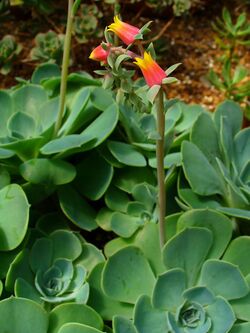Biology:Echeveria gibbiflora
| Echeveria gibbiflora | |
|---|---|

| |
| Scientific classification | |
| Kingdom: | Plantae |
| Clade: | Tracheophytes |
| Clade: | Angiosperms |
| Clade: | Eudicots |
| Order: | Saxifragales |
| Family: | Crassulaceae |
| Genus: | Echeveria |
| Species: | E. gibbiflora
|
| Binomial name | |
| Echeveria gibbiflora | |
| Synonyms[1] | |
| |
Echeveria gibbiflora is a species of flowering plant in the family Crassulaceae.[2][3][4] It was described by Swiss botanist Augustin Pyramus de Candolle in 1828. It occurs in Mexico and Guatemala.[1]
Description
Echeveria gibbiflora is a large species of Echeveria,[2][1] producing rosettes of 15 leaves, a tall flowering stem up to 1 metre (3 ft 3 in) in height, and an average of 160 flower buds.[5] The red, tubular flowers are about 2.5 centimetres (0.98 in) long with 10 stamens and 5 styles.[5][6] It flowers between September and January.[2][5] The dry fruits each produce approximately 200 small seeds.[5]
Ecology
Each flower is open for between 7–8 days and is visited by nectar-seeking broad-billed hummingbirds (Cynanthus latirostris).[6] The American bushtit (Psaltriparus minimus) has been documented foraging for aphids that occur among the flowers.[6]
Uses
Echeveria gibbiflora has been used in Mexican folk medicine as a contraceptive, as a vaginal postcoital rinse.[7][3]
Cultivars include E. gibbiflora 'Carunculata' (also spelled 'Caronculata'),[8] E. gibbiflora 'Metallica', and E. gibbiflora 'Violescens'.[9]
References
- ↑ 1.0 1.1 1.2 "Echeveria gibbiflora DC, 1828" (in de). International Crassulaceae Network. http://www.crassulaceae.ch/de/artikel?akID=48&aaID=2&aiID=G&aID=1220.
- ↑ 2.0 2.1 2.2 "Echeveria gibbiflora". Chicago Botanic Garden. https://www.chicagobotanic.org/plantcollections/plantfinder/echeveria_gibbiflora--echeveria.
- ↑ 3.0 3.1 Cordero-Martinez, Joaquín; Aguirre-Alvarado, Charmina; Guzmán-Soriano, Jessica Gabriela; Sánchez-Arroyo, Cinthia Erika; Flores-Alonso, Juan Carlos; Rodríguez-Páez, Lorena (27 July 2016). "Effects of aqueous crude extract of Echeveria gibbiflora on mouse sperm function". Systems Biology in Reproductive Medicine 62 (5): 343–52. doi:10.1080/19396368.2016.1203044. PMID 27463087.
- ↑ "Ruth's Tips: Echeveria 'Mauna Loa' an unusual beauty". The Mercury News. 26 September 2013. https://www.mercurynews.com/2013/09/26/ruths-tips-echeveria-mauna-loa-an-unusual-beauty/. Retrieved 25 April 2019.
- ↑ 5.0 5.1 5.2 5.3 Parra-Tabla, V.; Vargas, C. F.; Eguiarte, L. E. (August 1998). "Is Echeveria gibbiflora (Crassulaceae) fecundity limited by pollen availability? An experimental study". Functional Ecology 12 (4): 591–595. doi:10.1046/j.1365-2435.1998.00229.x. ISSN 0269-8463.
- ↑ 6.0 6.1 6.2 Parra, Victor; Vargas, C. Fabian; Eguiarte, Luis E. (February 1993). "Reproductive biology, pollen and seed dispersal, and neighborhood size in the hummingbird-pollinated Echeveria gibbiflora (Crassulaceae)". American Journal of Botany 80 (2): 153–159. doi:10.1002/j.1537-2197.1993.tb13783.x.
- ↑ Delgado, N. M.; Taboada Ramirez, J.; Ortega Hernández, A.; Merchant-Larios, H.; Sánchez-Vázqueź, M. L.; Ramirez, G.; Reyes, R. (1999). "Effects of a purified fraction from Echeveria gibbiflora aqueous crude extract on guinea-pig spermatozoa". Phytotherapy Research 13 (1): 46–49. doi:10.1002/(SICI)1099-1573(199902)13:1<46::AID-PTR373>3.0.CO;2-S. ISSN 0951-418X. PMID 10189950.
- ↑ "Echeveria gibbiflora 'Caronculata' De Smet" (in de). International Crassulaceae Network. http://www.crassulaceae.ch/de/artikel?akID=48&aaID=4&aiID=G&aID=3150. Retrieved 2018-11-07.
- ↑ Eggli, Urs (2012). Illustrated Handbook of Succulent Plants: Crassulaceae. Springer Science & Business Media. ISBN 9783642558740.
Wikidata ☰ Q15482278 entry
 |


